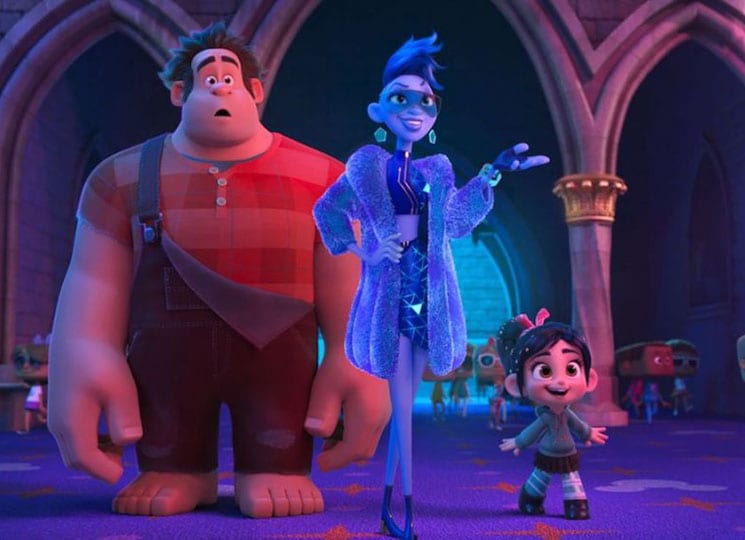The internet is a hellish cornucopia of pornography, racist trolls and change.org petitions, so it certainly isn't a suitable place for children. Ralph Breaks the Internet, on the other hand, imagines the web as a vibrant world of possibilities — a place where people go to shop, socialize and share cat videos. It makes for a cute, engaging movie with seemingly endless opportunities for Disney brand synergy.
The film picks up six years after 2012's Wreck-It Ralph. Sentient videogame characters Ralph (John C. Reilly) and Vanellope (Sarah Silverman) have settled nicely into a co-dependent friendship, and Ralph has overcome the bad-guy stigma that weighed on his conscience in the first movie. Their arcade just got WiFi, so when Vanellope's game, Sugar Rush, gets a broken part, our protagonists head online to buy a replacement. Naturally, Ralph unwittingly ends up wreaking havoc on the web.
The internet is represented as a futuristic cyber city, à la Blade Runner or The Jetsons, where websites are glittering skyscrapers and sprawling shopping malls. A few of the websites are fictional — like the video service BuzzzTube or the online game Slaughter Race — but most of them are real institutions like Google or Instagram. In fact, the entire plot hinges on Ralph and Vanellope making a purchase on eBay. I'm not sure if there's any overlap in the corporate Venn diagrams of Disney and eBay, but I certainly came away from the film with an insatiable desire to bid in an online auction.
There's even a scene in which our heroes go to the Disney website, where they meet Storm Troopers, Marvel superheroes and an entire gaggle of princesses (Snow White, Moana, Merida from Pixar's Brave, etc.). It's both a peculiar piece of meta-fiction and a shameless advertisement for Disney's many subsidiary film studios. Whichever brand strategist came up with this just earned a big Christmas bonus.
Despite its in-your-face marketing, Ralph Breaks the Internet is tons of fun. While the first film was an enjoyable hodgepodge of Pixar influences (primarily Toy Story and Monsters, Inc.) and retro gaming fetishization, this sequel improves on it with a big-hearted message about friendship and a well-crafted narrative arc.
And the real joy is seeing the creative ways in which the film renders the different aspects of the internet — pop up ads, search engines, the dark web — in its virtual world. If only the actual internet were this fun.
(Disney)The film picks up six years after 2012's Wreck-It Ralph. Sentient videogame characters Ralph (John C. Reilly) and Vanellope (Sarah Silverman) have settled nicely into a co-dependent friendship, and Ralph has overcome the bad-guy stigma that weighed on his conscience in the first movie. Their arcade just got WiFi, so when Vanellope's game, Sugar Rush, gets a broken part, our protagonists head online to buy a replacement. Naturally, Ralph unwittingly ends up wreaking havoc on the web.
The internet is represented as a futuristic cyber city, à la Blade Runner or The Jetsons, where websites are glittering skyscrapers and sprawling shopping malls. A few of the websites are fictional — like the video service BuzzzTube or the online game Slaughter Race — but most of them are real institutions like Google or Instagram. In fact, the entire plot hinges on Ralph and Vanellope making a purchase on eBay. I'm not sure if there's any overlap in the corporate Venn diagrams of Disney and eBay, but I certainly came away from the film with an insatiable desire to bid in an online auction.
There's even a scene in which our heroes go to the Disney website, where they meet Storm Troopers, Marvel superheroes and an entire gaggle of princesses (Snow White, Moana, Merida from Pixar's Brave, etc.). It's both a peculiar piece of meta-fiction and a shameless advertisement for Disney's many subsidiary film studios. Whichever brand strategist came up with this just earned a big Christmas bonus.
Despite its in-your-face marketing, Ralph Breaks the Internet is tons of fun. While the first film was an enjoyable hodgepodge of Pixar influences (primarily Toy Story and Monsters, Inc.) and retro gaming fetishization, this sequel improves on it with a big-hearted message about friendship and a well-crafted narrative arc.
And the real joy is seeing the creative ways in which the film renders the different aspects of the internet — pop up ads, search engines, the dark web — in its virtual world. If only the actual internet were this fun.
